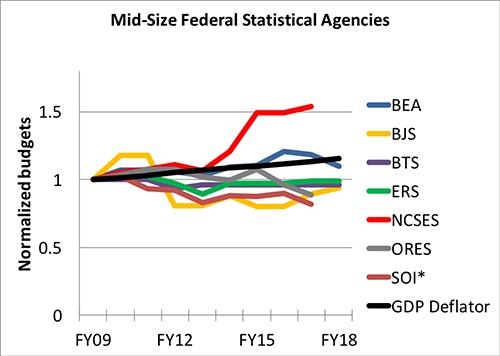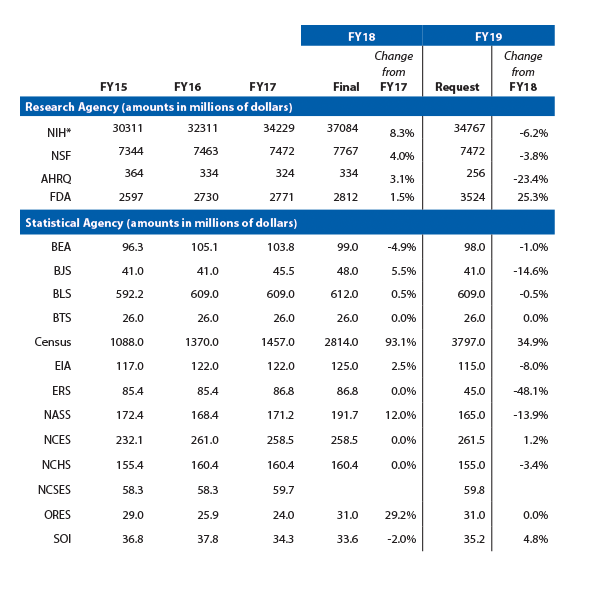Census, NIH, NSF Among Winners in FY18 Federal Budget
FY19 Budget Process Just Underway
Steve Pierson, ASA Director of Science Policy
After two short government shutdowns, a February deal between Congress and the administration raising the spending caps allowed the resolution of the fiscal year 2018 (FY18) budget in late March. Research-funding agencies and the US Census Bureau were among the entities benefitting most. Shortly after the deal, the administration released its FY19 budget request with hastily amended levels to account for the increased spending caps.
FY18 Final Budget
The additional discretionary funding provided in the February deal allowed Congress to generally reject the widespread cuts proposed in the FY18 administration request and go above the levels approved in their summer 2017 bills.
The FY18 omnibus bill has a $1.36 billion increase (93%) to $2.81 billion for the US Census Bureau, a much-needed increase as the bureau prepares for the decennial census in 23 months.
The amount is a welcome surprise because the House and Senate levels released last summer were only $1.5 billion and the modified administration request was only $1.7 billion. Advocates are praising the bipartisan effort—led by Sen. Richard Shelby (R-AL), Sen. Jeanne Shaheen (D-NH), Rep. John Culberson (R-TX), and Rep. Jose Serrano (D-NY)—to achieve this level at a crucial stage when the advertising and partnership campaigns must begin.
The National Institutes of Health (NIH) is also a big winner, with a $3 billion increase (8.8%) over FY17 to $37 billion, exceeding the prior House and Senate increases of approximately $1 billion and $2 billion, respectively. The omnibus bill has a welcome 4% increase for the National Science Foundation (NSF) to $7.87 billion in FY18, thanks to the afore-mentioned congressional leaders.
The omnibus bill flat funds the Bureau of Labor Statistics (BLS), National Center for Health Statistics (NCHS), National Center for Education Statistics (NCES), and Economic Research Service (ERS) and cuts the Bureau of Economic Analysis (BEA) 7.5%—levels that are disappointing considering the role of these agencies to our data infrastructure, which is so critical to US economic prosperity and competitiveness.
The FY18 levels for BLS and NCHS are especially concerning because these two agencies remain at their FY10 levels (as shown in Figure 1), thereby jeopardizing their programs, ability to innovate, and capacity to keep up with the changing economy (e.g., effects of gig economy, AI, robotics) and societal trends.
Returning to more encouraging news, the omnibus bill provides a 12% boost to the National Agricultural Statistics Service (NASS) for the quinquennial Census of Agriculture and small boosts to the Bureau of Justice Statistics (BJS) (5.5%) and Energy Information Administration (EIA) (2.5%).
Congress also rejected the administration’s proposed FY18 cuts to forensic science research and programs at the National Institute of Standards and Technology (NIST), adopting the Senate language to maintain these programs. The bill also funds the Agency for Healthcare Research and Quality (AHRQ) at $334 million, restoring it to its FY16 level after a $10 million cut in FY17 and attempts by the administration and House to cut its budget in FY18. Both AHRQ and NIST’s forensic science work are slated for cuts in the administration’s FY19 budget request.
Details are forthcoming for the FY18 budgets of the Internal Revenue Service Statistics of Income Division (SOI); National Center for Science and Engineering Statistics (NCSES); and the Social Security Administration Office of Research, Evaluation, and Statistics (ORES), though estimated FY18 budget levels were inserted at page proof stage as available.
The Bureau of Transportation Statistics (BTS) is not funded through the normal appropriations process—but by the Highway Trust Fund—and so is not influenced by either the FY18 budget deal or the FY19 request.
Turning to longer-term trends—already discussed for BLS and NCHS—one can see in Figures 1 and 2 that several other agencies have lost purchasing power since FY09, including BJS, BTS, ERS, NCES, ORES, and SOI. As pointed out last year, the FY17 SOI budget is off more than 20% in purchasing power since FY12, resulting in delayed release of some products, reductions of the content of other products, and hampered efforts to modernize data dissemination practices.

Figure 1: The budgets of five larger statistical agencies normalized to their FY09 levels, along with the GDP deflator to account for inflation. Census is omitted because of the large changes in the decennial census cycle. Budget restructuring for NASS and NCHS in FY15 is accounted for in the graph to allow for comparison over this period.

Figure 2: The budgets of the seven mid-sized statistical agencies normalized to their FY09 levels, along with the GDP deflator to account for inflation. Budget restructuring for ERS in FY15 is accounted for in the graph to allow for comparison over this period. One-time moving costs in FY16 for BEA are also omitted.
President’s FY19 Requested Budget
The administration’s fiscal year 2019 (FY19) budget was released February 12. Besides the increase proposed for the US Census Bureau and the 50% cut to the ERS, the proposal would generally cut or flat fund the federal statistical agency budgets as seen in Table 1. For NASS specifically, the quinquennial Census of Agriculture is fully funded, but the agricultural estimates programs are nearly $15 million below what is needed to maintain current programs and continue critical modernization efforts.

Table—1 FY15–FY18 Budgets and FY19 Requests for NIH, NSF, AHRQ, FDA, and the 13 Primary Federal Statistical Agencies
*The FY15, FY16, and FY17 levels for NIH are program levels.
The request holds the NSF and NIH close to their FY17 levels, which is relatively welcome news given the large cuts proposed for the two agencies in FY18. The administration was on track to again request large cuts to the two agencies in FY19, but amended their request after the FY18 and FY19 budget deal with Congress that raised the budget caps.
The administration again proposes to cut substantially the budget for AHRQ and to fold AHRQ into NIH. The FY19 request has a 25% increase for the US Food and Drug Administration (FDA) discretionary budget authority, mostly for its medical product work.
Many federal statistical agencies are facing critical staffing, program, and other budget challenges because of years of stagnant budgets. As a result, it remains critical for the statistical and broader community to urge their members of Congress to adequately fund these programs, the cornerstones of our data infrastructure and evidence-based policymaking.
Years of Stagnant Funding Impact BLS, NCHS
Flat budgets for the National Center for Health Statistics (NCHS) over many years have affected the agency’s ability to support existing and ongoing data collections that monitor the opioid epidemic, track change in health care use, and chart the prevalence of a wide range of health conditions and risk factors. Funding limitations have also resulted in staffing level cuts of almost 20%. Even more serious effects of the NCHS budgets will be felt in future years because NCHS’s ability to invest in innovation has been severely curtailed such that the agency is not able to make advances in the collection of electronic health records, the use of portable health measurement devices, and the securing of more detailed information from our vital records.
Without careful methodical innovation, experts caution NCHS will not be able to provide critical information about health and health care in the coming years. To make this point to Politico’s Danny Vinik in fall 2017, NCHS Director Charles Rothwell said, “It’s like driving an Indy car. We keep messing around with the engine, but maybe we ought to replace the engine at some point.”
The situation is equally troubling for Bureau of Labor Statistics (BLS), whose approximate loss in purchasing power is $80 million since FY09 and whose budget also saw a 5% cut in the intervening years. As a result, BLS advocates in the business and economic sectors have been stating a much higher level of urgency when making the case for its budget. Erica Groshen, 2013–2017 BLS commissioner, recently summarized the situation for a forthcoming Business Economics article:
To adjust temporarily, the BLS has slowed improvements, delayed training, cut research, and left vacancies unfilled. The agency can recover from such adjustments if funding is restored in subsequent years. However, this underfunding is not sustainable:
- First, the BLS cannot devote enough staff, data purchases, IT hardware, and software to better cover emerging economic trends (including the growing service sectors and the gig and digital economies) and expand use of ‘‘big data.’’ This is the path to irrelevance.
- Second, short staffing risks serious errors or last-minute delays in major statistical releases. Less training, outdated equipment and software, and fewer backups raise risks from mistakes and unforeseen events. This has not happened yet—thanks to BLS staff—but on this path it will, sooner or later.
If the decline in funding is not reversed, to avoid irrelevance and operational failures, the BLS must cut or shrink its existing programs. Across-the-board cuts generally do not work for the BLS, as this approach jeopardizes the quality of all BLS data. Instead, the BLS strategic approach is to eliminate specific product lines or entire surveys in order to maintain the quality and relevance of the remaining base programs. When deciding on program reductions, the BLS has protected its Principle Federal Economic Indicators (PFEI) and the programs that are written into or referenced by law for allocation or other purposes. Together, these prioritized programs account for more than 85% of the BLS budget. The remaining programs (the National Longitudinal Survey, JOLTS, American Time Use Survey, Census of Fatal Occupational Injuries, and Employee Benefits Survey) provide unique information on causes and effects of labor market outcomes and account for less than 10% of the budget. Cross program technical and management activities account for the remainder. In any event, even elimination of all the non-PFEI and non-legally required and referenced programs would be insufficient to fund the budget shortfall.
Other federal statistical agencies are also feeling the effect of flat budgets going back many years.


















Thank you Mr. Pierson, You are not alone in your concerns for the statistical agencies. Do I have your permission to use your table 1 (with attribution) in a presentation I will be giving next week at Georgetown University (a dress rehearsal for), Beyond the Numbers Conference this Nov, and then a version of the talk for the FDLP Webinar (no date yet).
https://www.library.georgetown.edu/event/2018-10-22t000000/ip-government-data-understanding-open-access-vs-public-domain
http://www.cvent.com/events/beyond-the-numbers/agenda-0c65833eabc649829ed55f1c0f8687a3.aspx
I would be thrilled if you can come to the talk on at Georgetown on Monday.
Thank you for considering giving your permission to use table 1.
Jennifer